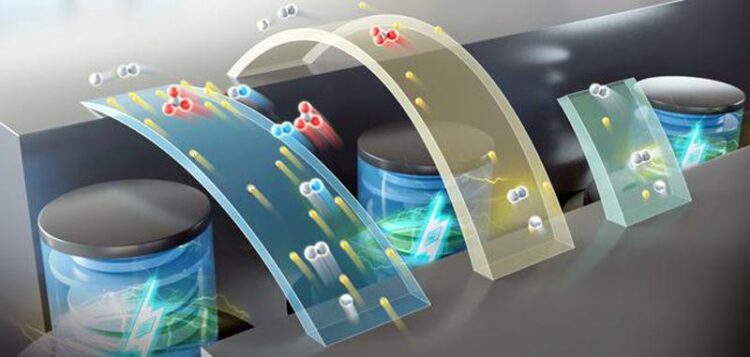High-energy-density aqueous battery based on halogen multi-electron transfer

Multi-electron transfer cathode based on bromo and iodine
Credit: DICP
Traditional non-aqueous lithium-ion batteries have a high energy density, but their safety is compromised due to the flammable organic electrolytes they utilize.
Aqueous batteries use water as the solvent for electrolytes, significantly enhancing the safety of the batteries. However, due to the limited solubility of the electrolyte and low battery voltage, aqueous batteries typically have a lower energy density. This means that the amount of electricity stored per unit volume of aqueous battery is relatively low.
In a new study published in Nature Energy, a research group led by Prof. LI Xianfeng from the Dalian Institute of Chemical Physics (DICP) of the Chinese Academy of Sciences (CAS), in collaboration with Prof. FU Qiang’s group also from DICP, developed a multi-electron transfer cathode based on bromine and iodine, realizing a specific capacity of more than 840 Ah/L, and achieving an energy density of up to 1200 Wh/L based on catholyte in full battery testing.
To improve the energy density of aqueous batteries, researchers used a mixed halogen solution of iodide ions (I–) and bromide ions (Br–) as the electrolyte. They developed a multi-electron transfer reaction, transferring I– to iodine element (I2) and then to iodate (IO3–). During the charging process, I– were oxidized to IO3– on the positive side, and the generated H+ were conducted to the negative side in the form of supporting electrolyte. During the discharge process, H+ were conducted from the positive side, and IO3– were reduced to I–.
The developed multi-electron transfer cathode had a specific capacity of 840 Ah/L. Combining the cathode with metallic Cd to form a full battery, researchers achieved an energy density up to 1200 Wh/L based on the developed catholyte.
Besides, researchers confirmed that Br– added to the electrolyte could generate polar iodine bromide (IBr) during the charging process, which facilitated the reaction with H2O to form IO3–. During the discharge, IO3– could oxidize Br– to Br2 and participated in the electrochemical reaction to realize reversible and rapid discharge of IO3–. Therefore, the bromide intermediate formed during the charge and discharge process optimized the reaction process, effectively improving the kinetic and reversibility of the electrochemical reaction.
Prof. FU’s group proved the multi-electron transfer process through in-situ optical microscopy, Raman spectroscopy and so on.
“This study provides a new idea for the design of high-energy-density aqueous batteries, and may expand the aqueous batteries application in power batteries field,” said Prof. LI.
Journal: Nature Energy
DOI: 10.1038/s41560-024-01515-9
Method of Research: Commentary/editorial
Subject of Research: Not applicable
Article Title: Reversible multielectron transfer I−/IO3− cathode enabled by a hetero-halogen electrolyte for high-energy-density aqueous batteries
Article Publication Date: 23-Apr-2024
Media Contact
Jean Wang
Dalian Institute of Chemical Physics, Chinese Academy Sciences
wangyj@dicp.ac.cn
Office: 41182464221
All latest news from the category: Life Sciences and Chemistry
Articles and reports from the Life Sciences and chemistry area deal with applied and basic research into modern biology, chemistry and human medicine.
Valuable information can be found on a range of life sciences fields including bacteriology, biochemistry, bionics, bioinformatics, biophysics, biotechnology, genetics, geobotany, human biology, marine biology, microbiology, molecular biology, cellular biology, zoology, bioinorganic chemistry, microchemistry and environmental chemistry.
Newest articles

How complex biological processes arise
A $20 million grant from the U.S. National Science Foundation (NSF) will support the establishment and operation of the National Synthesis Center for Emergence in the Molecular and Cellular Sciences (NCEMS) at…

Airborne single-photon lidar system achieves high-resolution 3D imaging
Compact, low-power system opens doors for photon-efficient drone and satellite-based environmental monitoring and mapping. Researchers have developed a compact and lightweight single-photon airborne lidar system that can acquire high-resolution 3D…

Simplified diagnosis of rare eye diseases
Uveitis experts provide an overview of an underestimated imaging technique. Uveitis is a rare inflammatory eye disease. Posterior and panuveitis in particular are associated with a poor prognosis and a…





















